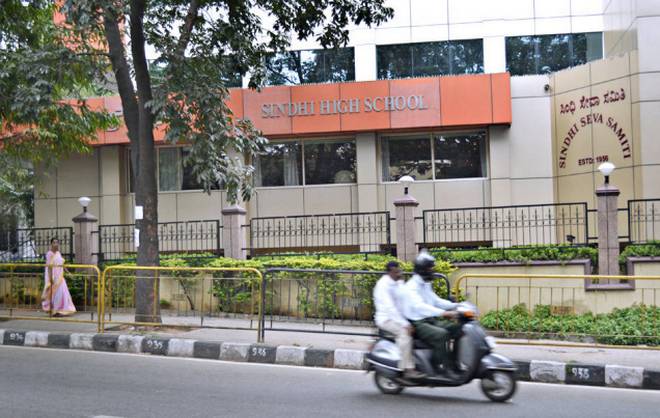
The Ladies’ Chapter also brought out a publication on the culture of Shikarpuri Sindhis, titled Sindhiyat.
By Anisha Sheth
Once the schoolchildren have left for the day, a group of women meet in the computer lab; downstairs, in the main hall of the school, several men in suits and ties gather for a separate meeting. The venue is the Sindhi High School in Kumara Park, where the Sindhi Seva Samiti and other Sindhi organizations often meet to discuss matters concerning the community.
Started in 1982 with the objective of “giving something back to society”, the high school has grown from 120 students enrolled in nursery to Class 2, to over 1,500 children enrolled in nursery through Class 12.
Since its inception, the school has admitted all eligible students and has not had a preference for Sindhi children, says principal of the school Maithreyi Satyadev. Biharilal Menda, the former president of the school management board, said that all the financial requirements of the school were taken care of by the Seva Samiti, and students were not charged capitation fees.
Substantial population
Kumara Park is one of the areas in Bangalore with a substantial Sindhi population. Other areas in the city include Shantinagar, Sindhi Colony and Cox Town.
Mr. Menda said the Sindhi community in Bangalore had largely organized itself into 13 associations, of which four were the most important: the Sindhi Seva Samiti, charged with running educational institutions; the Bangalore Ladies’ Chapter of the Sindhi Council of India, which organizes cultural activities; the Sindhi Youth Association, which runs a charitable hospital and the Puj Sindhi Panchayat, which looks after religious matters.
The Ladies’ Chapter also brought out a publication on the culture of Shikarpuri Sindhis, titled Sindhiyat. Henna Kalro, one of those who compiled the book, said it was the only documentation of the customs and culture of Shikarpuri Sindhis. “The idea for the book came about because my daughter is 19, and she doesn’t know anything [about Sindhi culture],” Ms. Kalro said.
President of the Ladies’ Chapter Shobha Kalro said the book took two years to put together. “We asked a lot of people, especially elderly women in many cities [in India and in Pakistan] what Sindh was like before 1947. We were writing in English, so we had to translate [from Sindhi to English], which was very difficult.”
Keeping track of a community that has its language included in the Indian Constitution but has no State, is a tough task, says Rajkumar Kukreja, a chartered accountant. However, although the earliest Sindhis who came to Bangalore did all kinds of work, including hawking on the streets, today the community has done well for itself, he says. “Land does not matter today, but it is important to keep the language [alive].”
Involving the youngsters
Mr. Kukreja and others across the country are coming up with novel ways to get the younger generation to take pride in their ‘sindhiyat’ and develop a love for the language.
One such effort was a countrywide competition in which families were asked to create quizzes about the community and language, sing songs and perform skits in Sindhi.
“One elderly woman came up to me backstage and asked me how she did; she said that her knees were shaking, but her son convinced her to perform,” Mr. Kukreja said.
Today, although third-generation Sindhis have developed a sense of belonging in their present homes, the ones who left Sindh still long to go back and see the land they left behind, says Ram Kapai, 49, whose grandfather arrived in Bangalore just before Partition.
‘Proud to be immigrants’
Saying that Sindhis were “proud to be immigrants”, Mr. Kapai added that they were very “adaptable”. Even when it came to marrying outside the community, Mr. Kapai claimed Sindhis were “way ahead of others”. “It never bothered us. [Marriage] is very personal, so we [elders] don’t interfere.”
Like Mr. Kureja, Mr. Kapai also feels that the Internet has greatly helped members of the community stay in touch with one another. “The Sindhi language was suffering, and now the Internet has brought us new hope,” Mr. Kapai said.
______________________
Courtesy: The Hindu